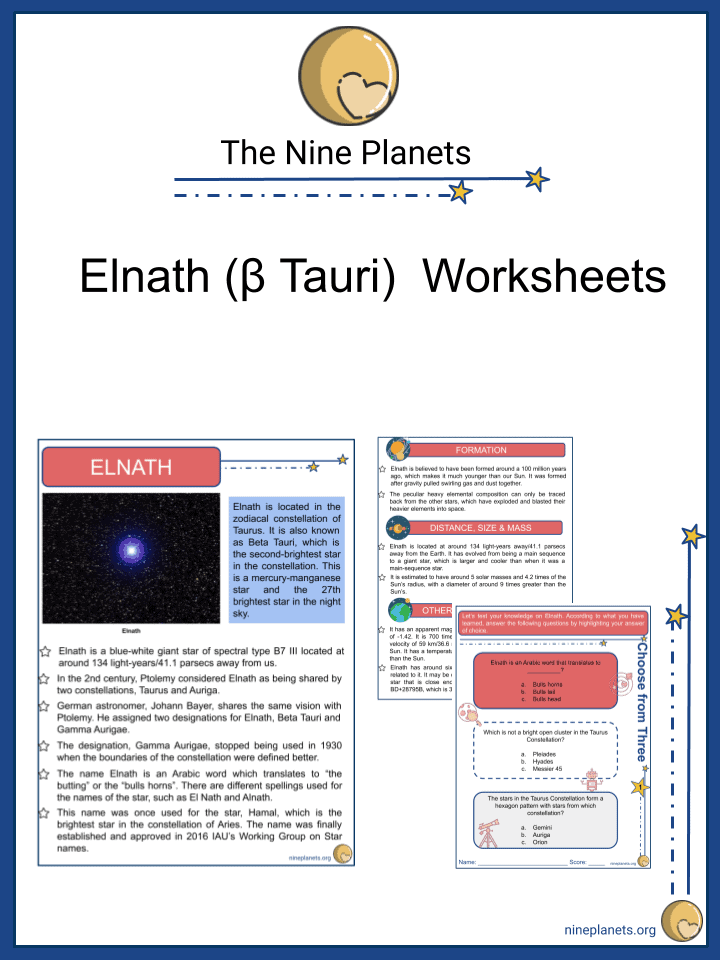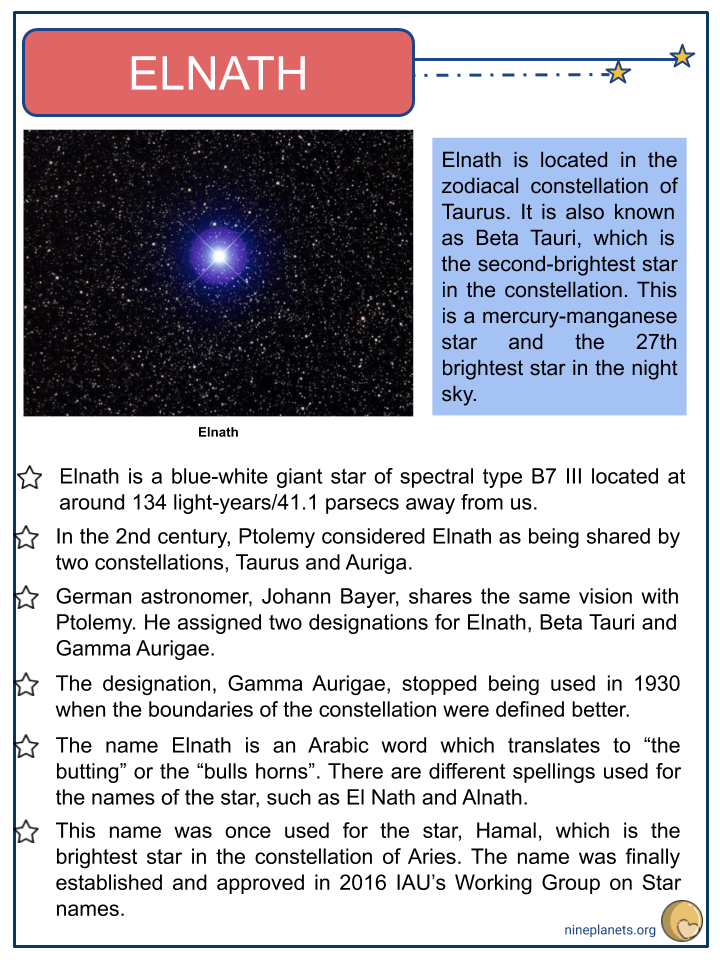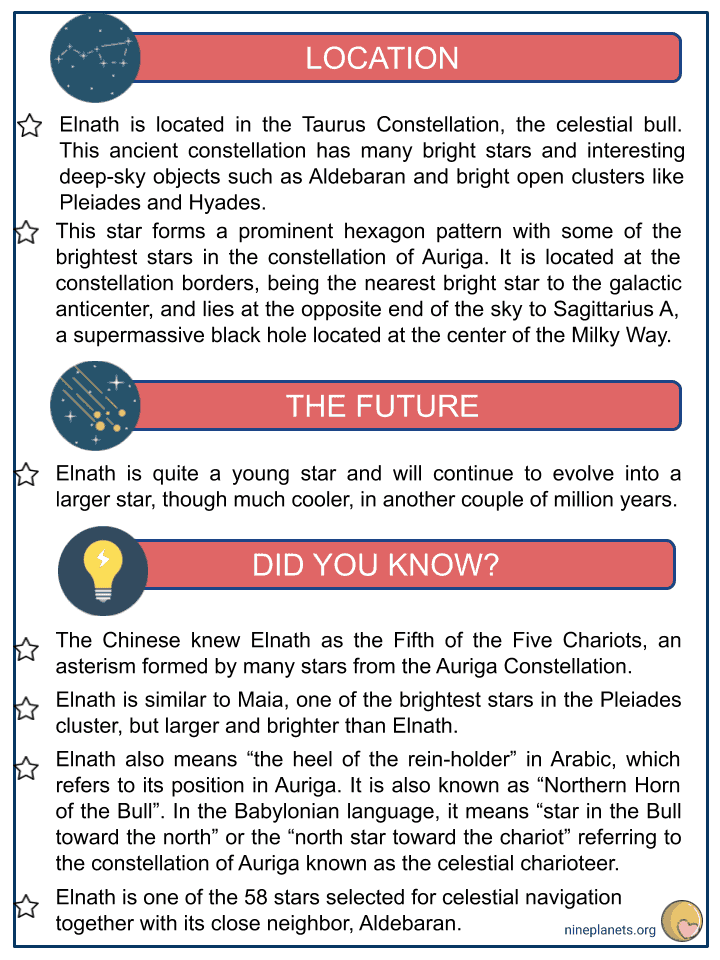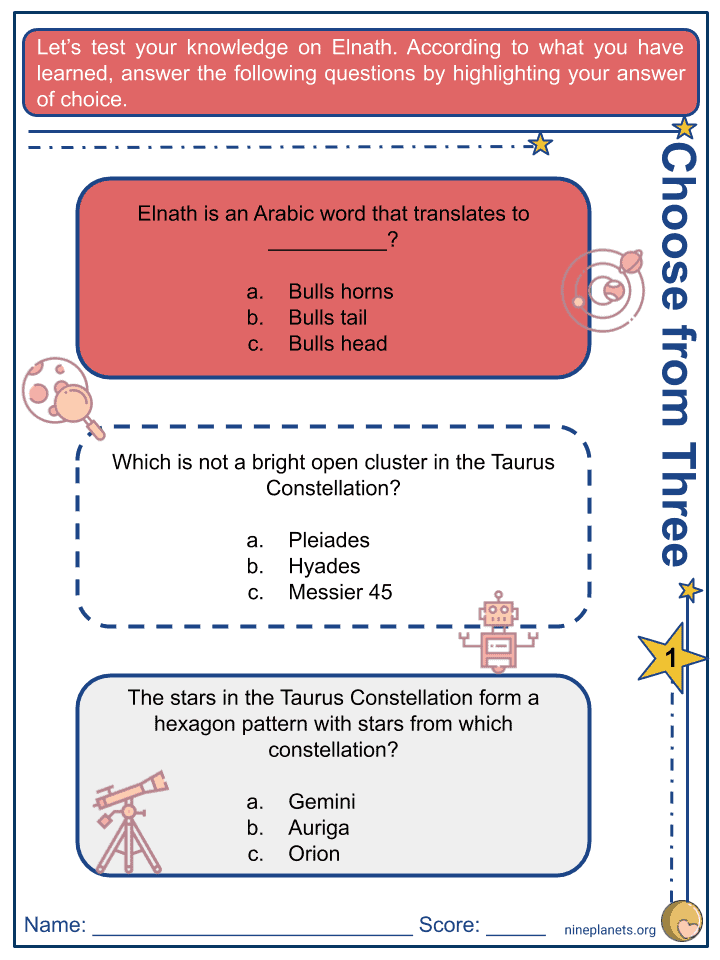Download Elnath (β Tauri) Worksheets
Click the button below to get instant access to these premium worksheets for use in the classroom or at a home.

This worksheet can be edited by Premium members using the free Google Slides online software. Click the Edit button above to get started.
Download free sample
Not ready to purchase a subscription yet? Click here to download a FREE sample of this worksheet pack.
Resource Examples
Click any of the example images below to view a larger version.




Key Facts & Information
- Elnath is located in the zodiacal constellation of Taurus. It is also known as Beta Tauri, which is the second-brightest star in the constellation. This is a mercury-manganese star and the 27th brightest star in the night sky.
- Elnath is a blue-white giant star of spectral type B7 III located at around 134 light-years/41.1 parsecs away from us.
- In the 2nd century, Ptolemy considered Elnath as being shared by two constellations, Taurus and Auriga.
- German astronomer, Johann Bayer, shares the same vision with Ptolemy. He assigned two designations for Elnath, Beta Tauri and Gamma Aurigae.
- The designation, Gamma Aurigae, stopped being used in 1930 when the boundaries of the constellation were defined better.
- The name Elnath is an Arabic word which translates to “the butting” or the “bulls horns”. There are different spellings used for the names of the star, such as El Nath and Alnath.
- This name was once used for the star, Hamal, which is the brightest star in the constellation of Aries. The name was finally established and approved in 2016 IAU’s Working Group on Star names.
Formation
- Elnath is believed to have been formed around a 100 million years ago, which makes it much younger than our Sun. It was formed after gravity pulled swirling gas and dust together.
- The peculiar heavy elemental composition can only be traced back from the other stars, which have exploded and blasted their heavier elements into space.
Distance, Size & Mass
- Elnath is located at around 134 light-years away/41.1 parsecs away from the Earth. It has evolved from being a main sequence to a giant star, which is larger and cooler than when it was a main-sequence star.
- It is estimated to have around 5 solar masses and 4.2 times of the Sun’s radius, with a diameter of around 9 times greater than the Sun’s.
Other Characteristics
- It has an apparent magnitude of 1.65 and an absolute magnitude of -1.42. It is 700 times brighter than the Sun with a rotational velocity of 59 km/36.6 miles per second, which is faster than the Sun. It has a temperature of around 13.824 K or 2.3 times hotter than the Sun.
- Elnath has around six visual companions but is not physically related to it. It may be considered as a binary star due to the faint star that is close enough to it. This companion is known as BD+28795B, which is 33.4 arcseconds far from Elnath.
Location
- Elnath is located in the Taurus Constellation, the celestial bull. This ancient constellation has many bright stars and interesting deep-sky objects such as Aldebaran and bright open clusters like Pleiades and Hyades.
- This star forms a prominent hexagon pattern with some of the brightest stars in the constellation of Auriga. It is located at the constellation borders, being the nearest bright star to the galactic anticenter, and lies at the opposite end of the sky to Sagittarius A, a supermassive black hole located at the center of the Milky Way.
The Future
- Elnath is quite a young star and will continue to evolve into a larger star, though much cooler, in another couple of million years.
Did You Know?
- The Chinese knew Elnath as the Fifth of the Five Chariots, an asterism formed by many stars from the Auriga Constellation.
- Elnath is similar to Maia, one of the brightest stars in the Pleiades cluster, but larger and brighter than Elnath.
- Elnath also means “the heel of the rein-holder” in Arabic, which refers to its position in Auriga. It is also known as “Northern Horn of the Bull”. In the Babylonian language, it means “star in the Bull toward the north” or the “north star toward the chariot” referring to the constellation of Auriga known as the celestial charioteer.
- Elnath is one of the 58 stars selected for celestial navigation together with its close neighbor, Aldebaran.